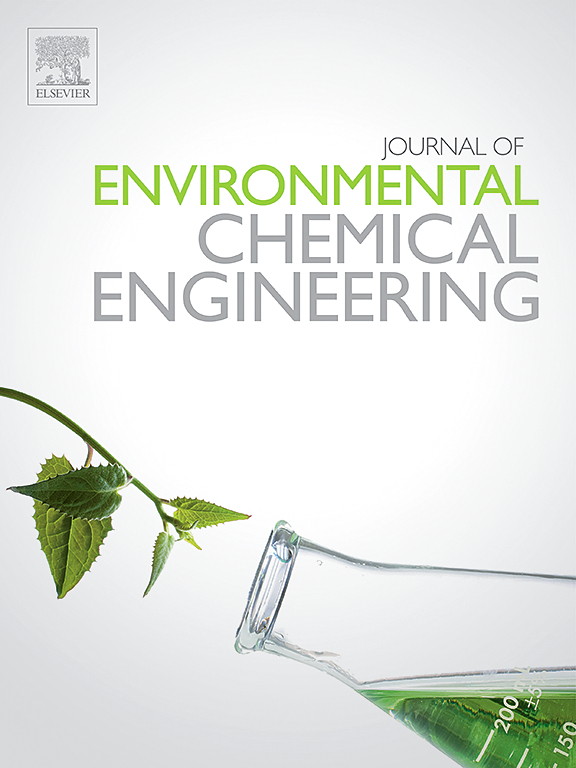环保合成的g-C3N4/[B]ZSM-5沸石纳米复合材料作为环氧涂料的智能填料,具有优异的防腐、自愈和疏水性能
IF 7.4
2区 工程技术
Q1 ENGINEERING, CHEMICAL
引用次数: 0
摘要
在这项研究中,我们设计了一种新型硼硅酸盐沸石/g-C₃N₄(GCN)复合材料,负载Zn 2 +离子,协同增强屏障保护和活性缓蚀。采用水热法制备高Si/B摩尔比硼硅酸盐沸石(B),以三聚氰胺为前驱体,经热缩聚和原位聚合制备g-C₃N₄(GCN)。在合成的纳米复合材料中,选择B-53.1 %GCN(含53.1 wt% GCN,经热重分析(TGA)测定)作为环氧基涂料的新型纳米填料。此外,利用沸石的阳离子交换能力和与GCN中氮的静电相互作用,在B、GCN和B-53.1 %GCN上负载了Zn 2 +离子(表示为B-Zn、GCN-Zn和B-53.1 %GCN-Zn)。在3.5 wt% NaCl溶液中,Zn 2 +离子的释放时间超过48 h,电化学阻抗谱(EIS)证实在钢上形成了保护膜。浸泡48 h后的Tafel(电位动力学)极化试验表明,B-53.1 % GCN-Zn同时抑制阳极和阴极反应,具有最高的缓蚀效率(80.2 %)。采用EIS、盐雾和阴极分层测试研究了含0.5 wt%合成填料(含/不含Zn 2 +)的环氧树脂(EP)涂层的阻挡性能。EP/B-53.1 % GCN和EP/B-53.1 % GCN- zn涂层表现出优异的防腐性能,浸泡202天后,|Z|₁₀Hz值分别是裸环氧树脂的813倍和912倍。此外,与未改性的环氧树脂相比,浸泡在3.5 wt% NaCl中的划伤涂层表现出自愈行为,EP/B-Zn和EP/B-53.1 %GCN-Zn的Rt(total)(Rcoat(c) +Rcharge transfer(ct))值增加。本文章由计算机程序翻译,如有差异,请以英文原文为准。
Eco-friendly synthesized g-C3N4/[B]ZSM-5 zeolite nanocomposites as smart fillers for epoxy coatings with excellent anticorrosion, self-healing, and hydrophobic performance
In this study, we design a novel borosilicate zeolite/g-C₃N₄ (GCN) composite loaded with Zn²⁺ ions to synergistically enhance barrier protection and active corrosion inhibition. Borosilicate zeolite (B) with a high Si/B molar ratio was synthesized via the hydrothermal method and subsequently composited with g-C₃N₄ (GCN) through thermal condensation and in situ polymerization using melamine as a precursor. Among the synthesized nanocomposites, B-53.1 %GCN (containing 53.1 wt% GCN, as determined by thermogravimetric analysis (TGA)) was selected as a novel nanofiller for epoxy-based coatings. Additionally, B, GCN, and B-53.1 %GCN were loaded with Zn²⁺ ions (denoted as B-Zn, GCN-Zn, and B-53.1 %GCN-Zn) leveraging the cation exchange capability of zeolites and electrostatic interactions with nitrogen in GCN. The release of Zn²⁺ ions in 3.5 wt% NaCl solution was tracked over 48 h, while electrochemical impedance spectroscopy (EIS) confirmed the formation of a protective film on steel. Tafel (potentiodynamic) polarization tests after 48 h of immersion revealed that B-53.1 % GCN-Zn exhibited the highest corrosion inhibition efficiency (80.2 %) by simultaneously suppressing anodic and cathodic reactions. Epoxy (EP) coatings containing 0.5 wt% of the synthesized fillers (with/without Zn²⁺) were investigated for their barrier properties using EIS, salt spray, and cathodic delamination tests. The EP/B-53.1 % GCN and EP/B-53.1 % GCN-Zn coatings demonstrated superior anti-corrosion performance, with |Z|₁₀ₘHz values 813 and 912 times greater than bare epoxy after 202 days of immersion, respectively. Furthermore, scratched coatings immersed in 3.5 wt% NaCl exhibited self-healing behavior, as evidenced by increased Rt(total)(Rcoat(c) +Rcharge transfer(ct)) values for EP/B-Zn and EP/B-53.1 %GCN-Zn compared to unmodified epoxy.
求助全文
通过发布文献求助,成功后即可免费获取论文全文。
去求助
来源期刊

Journal of Environmental Chemical Engineering
Environmental Science-Pollution
CiteScore
11.40
自引率
6.50%
发文量
2017
审稿时长
27 days
期刊介绍:
The Journal of Environmental Chemical Engineering (JECE) serves as a platform for the dissemination of original and innovative research focusing on the advancement of environmentally-friendly, sustainable technologies. JECE emphasizes the transition towards a carbon-neutral circular economy and a self-sufficient bio-based economy. Topics covered include soil, water, wastewater, and air decontamination; pollution monitoring, prevention, and control; advanced analytics, sensors, impact and risk assessment methodologies in environmental chemical engineering; resource recovery (water, nutrients, materials, energy); industrial ecology; valorization of waste streams; waste management (including e-waste); climate-water-energy-food nexus; novel materials for environmental, chemical, and energy applications; sustainability and environmental safety; water digitalization, water data science, and machine learning; process integration and intensification; recent developments in green chemistry for synthesis, catalysis, and energy; and original research on contaminants of emerging concern, persistent chemicals, and priority substances, including microplastics, nanoplastics, nanomaterials, micropollutants, antimicrobial resistance genes, and emerging pathogens (viruses, bacteria, parasites) of environmental significance.
 求助内容:
求助内容: 应助结果提醒方式:
应助结果提醒方式:


